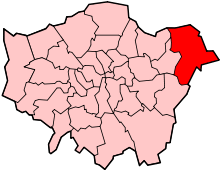St Andrew's Church, Hornchurch
| St Andrew's Church, Hornchurch | |
|---|---|
 St Andrews Church, Hornchurch | |
| Denomination | Church of England |
| Website | The parish of Hornchurch |
| Administration | |
| Deanery | Havering |
| Archdeaconry | Barking |
| Diocese | Chelmsford |
| Province | Canterbury |
| Clergy | |
| Vicar(s) | Barry Hobson |
| Laity | |
| Organist(s) | Andrew Losq |
| Churchwarden(s) | David Butcher and Anne Jarrett |
The church of St Andrew's, Hornchurch, is a Church of England religious building in Hornchurch, England. It is a Grade I listed building.
History
During the Anglian ice age around 450,000 years ago, the ice sheet reached The Dell, a few metres south of the current location of the church. This is the furthest south reached by any ice sheet in Britain during the Pleistocene epoch.[1]
There has been a church on this site since at least 1163. The tower and the north porch were added in the 15th century.[2] The tower contains 10 bells hung in a clockwise ring. The tenor is 18cwt (2016 lb or 914 kg) in Eb (622.0 Hz) dating from 1779.[3] The bells were augmented from six bells to eight in 1901, then from eight to ten in 2001.[4] On Monday May 27, 1912 a band of ringers led by William Pye rang a peal of 15,264 changes of Bristol Surprise major in 9 hours and 49 minutes. This was at the time the longest length rung in any surprise method.[5]
Design
The current church is an example of late Gothic architecture.[2] It was designated as a Grade I listed building by Historic England in 1955.[6]
Interments
St Andrew's contains a number of funereal monuments and memorials to local families and dignitaries. Among these are memorials to the daughters of William Blackborne, who lived at Hornchurch and who was related to Abraham Blackborne, the long-serving rector (58 years) of Dagenham, as well as Levett Blackborne, Lincoln's Inn barrister and grandson of Sir Richard Levett, Lord Mayor of London.[7] In addition to the Blackborne memorial, there is also a stone tablet incised with verses proclaiming it as the resting place of the "Right Hon. Thomas Clutterbuck, treasurer of the Navy, and one of his Majesty's (king George II) most honourable privy council," who died 1742.[8] The churchyard contains the war graves of 37 Commonwealth service personnel of World War I and four of World War II.[9]
| Wikimedia Commons has media related to St Andrew's Church. |
References
- ↑ "Geology Site Account, The Dell". The Essex Field Club.
- 1 2 "Archived copy". Archived from the original on 2010-10-28. Retrieved 2008-09-04.
- ↑ Retrieved from Dove's Guide http://dove.cccbr.org.uk/detail.php?searchString=hornchurch&Submit=+Go+&DoveID=HORNCHURCH
- ↑ http://www.hornchurchbells.co.uk/bells.aspx
- ↑ http://www.parishofhornchurch.co.uk/assets/files/Bullseye%20May%202012.pdf
- ↑ "PARISH CHURCH OF ST ANDREW", Historic England, accessed 4 November 2017.
- ↑ Essex Review: An Illustrated Quarterly Record of Everything of Permanent Interest in the County, Vol. 5, Published by E. Durant and Co., 1896
- ↑ The History of Essex: From the Earliest Period to the Present Time, Elizabeth Ogborne, Printed for the Proprietors and sold by R.H. Kelham, London, 1814, retrieved 14 March 2015
- ↑ CWGC Cemetery Report. Breakdown obtained from casualty record.
